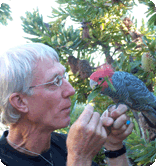How can I reduce the tension between my birds?

We currently have two African Grey parrots, Peaches who is five years old and Vincent who is two (nearly three) years old. Peaches has always been a very laid back bird and never shown any signs of stress, we worked through feather destructive behaviours with Vincent when he reached puberty, finding it appeared to be a combination of a food allergy and certain time
of year and fingers crossed he is now fully feathered and not chewing/plucking.
Peaches is much more solitary than Vincent in that she prefers to interact with humans, namely my husband, myself and even my daughters and grandson, where as Vincent wants to become friendly with Peaches, from observations this appears to be stressing Peaches and she tends to "escape" byhiding on us or flying to her favourite perch. It has got so bad in the
last few months or so the Peaches seems so distressed that she wants to come everywhere with me so she is not left with Vincent. Unfortunately this is upsetting Vincent as he now want to be with me too so he can be close to Peaches. It's almost akin to parrot stalking. Both birds have their own cage and play stands as Peaches has never wanted to interact with Vincent even when we brought him home, we spent weeks slowly introducing them and trying to get them to stand together to no avail, obviously Peaches wasn't interested in the new addition preferring one of her human mates instead (we are Peaches play stand in effect). I say Peaches is female and Vincent is male but neither bird has been sexed so I could be wrong.
One not very helpful comment I got from a breeder was that Vincent would be happier in a flight with other greys so I should just give him up. This is the last thing I'd want to do as I'd feel I was giving up on him and he is a very loving bird and does interact with us and allows us the privilege of scratching his head and sitting on us. He just wants more interaction with Peaches who couldn't care less about him. We have thought long and hard how to resolve this but the only solution we feel may help is adopting a new bird to help ease the stress between
Peaches and Vincent , hopefully giving Vincent the companion he wants and letting Peaches revert back to her own stress free world. I've also thought of the new bird and yes I have lots of love, time and attention I could give to it to help it adjust to our flock.
I guess my questions are is this likely to cause more stress for my birds is there something else I could do to reduce the tension between my birds.
I feel that I am failing both birds at the moment as I am not meeting either of their needs completely.

Dear Jo, First of all it is fine to remember that none of us ever meets the needs of our parrots “completely” in a captive situation, and I applaud you for doing the best you can with these two greys.
It is not unusual to find female hand raised psittacines that have absolutely no interest in befriending a male bird of their species. This is one of the pitfalls of being raised as orphans without adult parrot interaction and role models. April and I have the same dysfunctional situation with two of our female macaws. Both crave affections, but disdain the males we have offered them as companions.
Now that being given, it would appear that Peaches is most content with you humans and the best resolution at this time would be to keep her happy and healthy and stress free by being a loved pet. She is the older of the two greys and would both be more likely not to really take to a new arrival as per the two year old Vincent; plus she would be the one to preferably be given the lead where any sexuality enters the situation.
If she were to get nesty and start discovering dark corners and shredding materials, then her mind might be more likely to turn to Vincent for certain need satisfactions. This could happen any year now, but who knows?
It is not something we want to pressure our well-adjusted pet parrots to do, since accepting a mate, choosing to lay eggs, and all that goes with this road can bring as many complications for you and your birds as it solves…
Now, the question of whether to acquire yet another parrot to befriend Vincent and thus satisfy his desires at present is something you must think over carefully. Threesomes in parrot households can be interesting, but changeable and competitive. The best scenario would be if you were able to do a trial with another grey hen and make absolutely sure that Vincent would
like and accept her and vice versa. Otherwise you have gone out and acquired a third bird that may be a third “single” and need things other than what we humans project!
Another way of approaching the problem would be to try and take Vincent’s focus off of Peaches. Give them less time in the same sight and sound space, offer him outdoor cage stimulation and natural tree boughs and flowers and grass and sandy soil in a tray to dig around in, perhaps a cardboard play box with several entrance holes to be his own “hideaway.” Diversion is a
great tool for obsessive but celibate parrots!
When Peaches gets to see these things happening, she may be attracted to the activities. Shared activities are the best way to get two parrots to befriend one another without letting one dominate the other and cause fears or timidity. That means shared baths, shared foraging, shared exploration of interesting things like hollow logs, palm plants, etc. If Peaches does not
take to such activities readily, chances are you have a hen like our macaws—not coincidentally these two spend very little time entertaining themselves and disdain normal toys and play.
I wish you luck in your endeavor. Please keep in touch with WPT. And keep in mind that if Vincent is only two, he has quite a few phases to go through yet before he becomes a routinely predictable adult male grey.
With aloha, EB

































